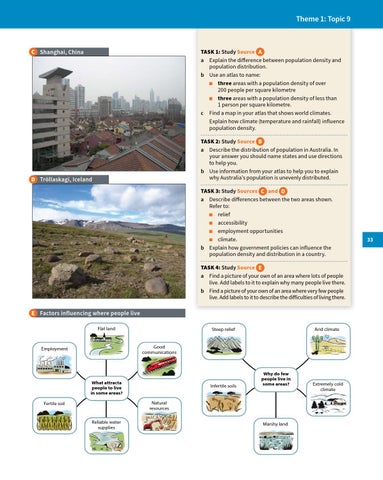Theme 1: Topic 9
TASK 1: Study Source a Explain the difference between population density and population distribution. b Use an atlas to name: ■ three areas with a population density of over 200 people per square kilometre ■ three areas with a population density of less than 1 person per square kilometre. c Find a map in your atlas that shows world climates. Explain how climate (temperature and rainfall) influence population density.
Shanghai, China
TASK 2: Study Source a Describe the distribution of population in Australia. In your answer you should name states and use directions to help you. b Use information from your atlas to help you to explain why Australia’s population is unevenly distributed.
Tröllaskagi, Iceland
TASK 3: Study Sources and a Describe differences between the two areas shown. Refer to: ■ relief ■ accessibility ■ employment opportunities ■ climate. b Explain how government policies can influence the population density and distribution in a country. TASK 4: Study Source a Find a picture of your own of an area where lots of people live. Add labels to it to explain why many people live there. b Find a picture of your own of an area where very few people live. Add labels to it to describe the difficulties of living there.
Factors influencing where people live Flat land
Steep relief
Arid climate
Good communications
Employment
What attracta people to live in some areas?
Infertile soils
Why do few people live in some areas?
Natural resources
Fertile soil
Reliable water supplies
Marshy land
Extremely cold climate
33
